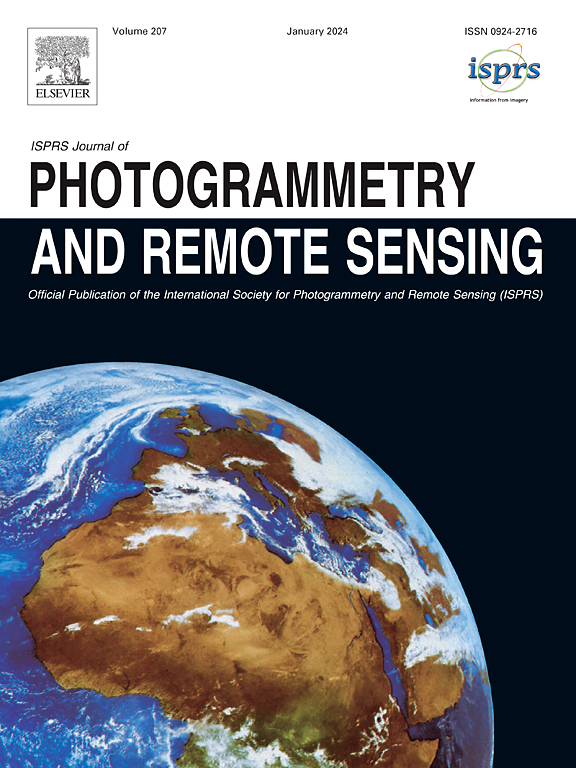微小目标检测与单点监督
IF 10.6
1区 地球科学
Q1 GEOGRAPHY, PHYSICAL
ISPRS Journal of Photogrammetry and Remote Sensing
Pub Date : 2025-06-17
DOI:10.1016/j.isprsjprs.2025.05.006
引用次数: 0
摘要
空间分辨率有限的微小物体通常类似于点状分布。因此,使用点级监督的边界盒预测成为传统盒级监督的一种自然且经济的替代方案。然而,微小物体的小尺度和缺乏显著特征使得点标注容易产生噪声,这对模型的鲁棒性构成了重大障碍。为了解决这些挑战,我们提出了点教师——第一个端到端点监督方法,用于航空图像中的鲁棒微小目标检测。为了处理由尺度模糊和点注释中的位置移动引起的标签噪声,point Teacher采用师生结构,并将学习解耦为两阶段去噪过程。在这个框架中,教师网络逐步去噪由噪声点注释产生的伪框,指导学生网络的学习。具体来说,在第一阶段,对图像区域进行随机掩蔽,便于回归学习,使教师能够将有噪声的点标注转化为粗糙的伪框。在第二阶段,使用动态多实例学习对这些粗伪盒进行细化,从粗伪盒周围动态构造的建议包中自适应地选择最可靠的实例。在三个微小目标数据集(即ai - todd -v2, SODA-A和TinyPerson)和多尺度目标数据集DOTA-v2上进行的大量实验验证了该方法对点位置移动的有效性和鲁棒性。值得注意的是,仅依靠点监督,我们的点教师已经显示出与盒监督学习方法相当的性能。代码可从https://github.com/ZhuHaoranEIS/Point-Teacher获得。本文章由计算机程序翻译,如有差异,请以英文原文为准。
Tiny object detection with single point supervision
Tiny objects, with their limited spatial resolution, often resemble point-like distributions. As a result, bounding box prediction using point-level supervision emerges as a natural and cost-effective alternative to traditional box-level supervision. However, the small scale and lack of distinctive features of tiny objects make point annotations prone to noise, posing significant hurdles for model robustness. To tackle these challenges, we propose Point Teacher—the first end-to-end point-supervised method for robust tiny object detection in aerial images. To handle label noise from scale ambiguity and location shifts in point annotations, Point Teacher employs the teacher–student architecture and decouples the learning into a two-phase denoising process. In this framework, the teacher network progressively denoises the pseudo boxes derived from noisy point annotations, guiding the student network’s learning. Specifically, in the first phase, random masking of image regions facilitates regression learning, enabling the teacher to transform noisy point annotations into coarse pseudo boxes. In the second phase, these coarse pseudo boxes are refined using dynamic multiple instance learning, which adaptively selects the most reliable instance from dynamically constructed proposal bags around the coarse pseudo boxes. Extensive experiments on three tiny object datasets (i.e., AI-TOD-v2, SODA-A, and TinyPerson) and a multi-scale object dataset DOTA-v2 validate the proposed method’s effectiveness and robustness against point location shifts. Notably, relying solely on point supervision, our Point Teacher already shows comparable performance with box-supervised learning methods. Code is available at https://github.com/ZhuHaoranEIS/Point-Teacher.
求助全文
通过发布文献求助,成功后即可免费获取论文全文。
去求助
来源期刊

ISPRS Journal of Photogrammetry and Remote Sensing
工程技术-成像科学与照相技术
CiteScore
21.00
自引率
6.30%
发文量
273
审稿时长
40 days
期刊介绍:
The ISPRS Journal of Photogrammetry and Remote Sensing (P&RS) serves as the official journal of the International Society for Photogrammetry and Remote Sensing (ISPRS). It acts as a platform for scientists and professionals worldwide who are involved in various disciplines that utilize photogrammetry, remote sensing, spatial information systems, computer vision, and related fields. The journal aims to facilitate communication and dissemination of advancements in these disciplines, while also acting as a comprehensive source of reference and archive.
P&RS endeavors to publish high-quality, peer-reviewed research papers that are preferably original and have not been published before. These papers can cover scientific/research, technological development, or application/practical aspects. Additionally, the journal welcomes papers that are based on presentations from ISPRS meetings, as long as they are considered significant contributions to the aforementioned fields.
In particular, P&RS encourages the submission of papers that are of broad scientific interest, showcase innovative applications (especially in emerging fields), have an interdisciplinary focus, discuss topics that have received limited attention in P&RS or related journals, or explore new directions in scientific or professional realms. It is preferred that theoretical papers include practical applications, while papers focusing on systems and applications should include a theoretical background.
 求助内容:
求助内容: 应助结果提醒方式:
应助结果提醒方式:


